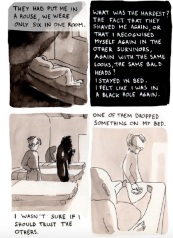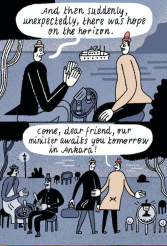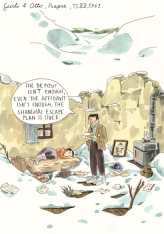In the second part of the project, “Escape and Migration in Europe”, we explored the history of flight and migration as a consequence of National Socialism. The scope of the project, however, went beyond the historical events of this period as participants also examined the medium- and long-term impact of escape and migration. These consequences are passed down from generation to generation and are still discernible in today’s societies. This approach allowed us to draw parallels between historic and current events (e.g. refugee and migration flows to Europe) with the aim of fostering a better understanding of history among the participating artists and youth, as well as the general public.
“Escape and Migration in Europe” took place in Naples, Italy, and Leipzig, Germany, throughout 2018 and 2019. It was funded by the Federal Agency for Civic Education (bpb) and Goethe-Institut Rom in cooperation with Goethe-Institut Neapel, Anne Frank Zentrum Berlin and kuš!.
All comics were published in an anthology by kuš! in March 2019. They were featured in an exhibition at neurotitan Berlin from 16 March to 4 April 2019.
“Escape” by Lina Itagaki
Lina Itagaki’s comic tells the story of Polish Jewish refugees who managed to escape the ghettos and concentration camps in Poland. After their arrival in Kaunas, Lithuania, the resident Japanese vice consul Chiune Sugihara issued them “visas for life”. Those visas allowed them to travel by train to Vladivostok, Russia, and onwards by ferry to Tsuruga, Japan. They continued onwards to Kobe and eventually New Zealand – maybe even further South. Lina’s comic tells a story of escape, courage, motivation, and of honest people who risked everything for the lives of others. Sugihara is the only Japanese national to be honoured as one of the “Righteous Among the Nations” by the State of Israel.
“I Crossed Italy” by Emilie Josso
After WW2 had come to an end, numerous camps for displaced persons sprang up all over Italy. Many of them served as “roads”: one towards the South for Jews who chose to go to Palestine, another towards the ports of the Mediterranean for those who went to America or Australia. Emilie’s comic begins at the Brenner, which most refugees had to cross, and moves on to South Tyrol, which had a complex connection with displaced persons. It tells the story of how emigration roads in Italy were organised on a political as well as practical level. Set in a DP camp, it depicts Jewish, Ukrainian and Baltic refugees trying to move on, set on different destinations, following informal roads of displacement.
“New Horizons” by Julia Kluge
Based on the “Law on the Restoration of Civil Service”, which was passed in 1933, the National Socialists were able to dismiss numerous Jews and dissidents from public service. Among them was Philipp Schwartz, an anatomist and pathologist teaching at Frankfurt University. Upon his dismissal, he was forced to move to Zurich where he founded an association for German scientists in exile. Schwartz successfully struck up relations with Turkey and helped several hundred scientists to emigrate across the Bosporus. Schwartz himself moved to Istanbul where he was made director of the Institute of Pathology of Istanbul University. Julia Kluge’s comic tells the story of his emigration to Turkey as well as of his failed attempt to return to Frankfurt University after the war.
“Pink Donkeys” by Alice Socal
Heinz Skall, born into a Jewish family in Prague and raised in Vienna, managed to escape death in a concentration camp – unlike the rest of his family. When World War II broke out, Skall was living in Italy. In accordance with the Nuremberg Laws, which the National Socialist regime had passed as early as 1935, Skall was sent to an internment camp in Campagna (province of Salerno/South Italy). Despite all odds, the local population, which was mostly poor and uneducated, struck up friendships with the Jewish doctors, artists and intellectuals in the camp. Alice Socal tells Skall’s story through the letters and drawings he sent back to his family in Vienna during his internment. One of the anecdotes that Skall was fond of telling included the allegedly pink donkeys of Campagna.



